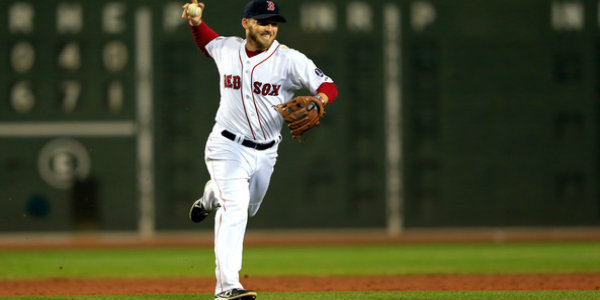2014 Fantasy Baseball: Stephen Drew Rejoins the Red Sox


It’s not often that a player that can make a fantasy impact is a free agent in who signs in May, but Stephen Drew is a free agent no longer, and he’ll be ready to help fantasy teams soon. Red Sox Manager John Farrell indicated in a press conference on Tuesday that Drew will only need about 25 at-bats in the minors before he believes he’ll be ready to join the active roster. That’s not many at-bats, and it means that the 31-year old shortstop should be playing games with the Red Sox sometime next week. The question for fantasy gamers is what can be expected of Drew, and what size leagues will he be useful in?
Setting the baseline at his line last year, his first and only full season with the Red Sox, seems reasonable. Drew hit .253/.333/.443 with 13 homers and six stolen bases in 501 plate appearances. That’s not a line that warrants ponying up all of your FAAB budget for or bowling over his present owner with a monster offer in the event he was already being stashed, but it plays at middle infield in 12-team mixed leagues or AL-only formats.
Despite the fact Drew has a 15 homer season and a 21 homer season on his resume, I don’t see him approaching 20 this year (even at a pro-rated pace). The reason is simple, he played his home games at Chase Field in 2008 when he swatted 21 homers, and he plays at Fenway Park now. StatCorner uses a rolling three year average for park factors, and the park factors I’m going to cite are for after the 2008 season, so take them with a grain of salt as they apply to Drew. The left-handed batter homer factor for Chase Field is 107. The left-handed batter homer park factor falls woefully short of that at Fenway Park where it is 68. A dozen homers, give or take a couple, is a fair projection.
As for Drew’s batting average, there might be a little more upside there. His .320 BABIP last year was 13 points above his career mark, but over the last three seasons Drew’s line drive rate has been up and more than a quarter of the balls he has put in play have been of the line drive variety the last two years according to FanGraphs batted ball data. When you factor his batted ball profile in, the .320 BABIP doesn’t smell funny.
The reason for my optimism about Drew pushing his batting average closer to his career mark of .264 than his .253 mark last year is a belief that he’ll cut back some on his strikeouts. His 24.8 percent strikeout rate last year was a career high, one year after setting a then career high of 23.2 percent in 2012. I don’t think he’ll cut his strikeout rate down to his career mark of 18.6 percent, but FanGraphs had his swinging strike rate (8.9 percent) lower than the league average (9.3 percent), and the league average strikeout rate last year was 19.9 percent. I believe Drew will strikeout in closer to 20 percent of his plate appearances this year than 25 percent of them, and while that seems like a negligible difference, it could be a few more hits.
Drew should be added in all AL-only leagues and any large mixed league using a middle infield position where there are few bench spots. He should play most every day at shortstop with Xander Bogaerts moving over to third base and Will Middlebrooks moving to the bench. Those rostering Drew should be aware of his sizable platoon split. The left-handed hitter has an ugly triple slash line of .235/.291/.390 in 1,071 plate appearances against southpaws in his career. Against right-handed pitchers he has been excellent (for a shortstop) hitting .275/.343/.451 in 2,847 plate appearances. If you’re in a league with a large enough bench and daily lineup changes, Drew can be optimally used by shielding him from lefties. Daily fantasy gamers are going to benefit the most from the return of Drew as he’s a nifty option at shortstop when he’s facing a right-handed pitcher, especially since his price tag figures to be low out of the gate.





